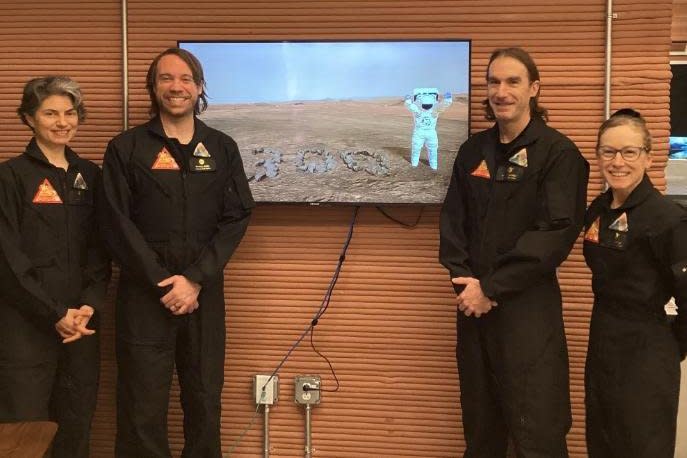Crew inside NASA's Mars habitat simulator to exit after more than a year

July 2 (UPI) -- The first volunteer crew, to live for more than a year inside NASA's Mars habitat at the Johnson Space Center in Houston, will exit the simulated Red Planet ground mission on Saturday.
Crew members Kelly Haston, Anca Selariu, Ross Brockwell and Nathan Jones will be greeted with a short welcome ceremony at about 5 p.m. EDT, which can be viewed on NASA+, NASA Television, the NASA app and the space agency's website, when they walk out of Crew Health and Performance Exploration Analog's, or CHAPEA's, 3D printed habitat after 378 days.
CHAPEA's Mars Dune Alpha is an isolated 3D-printed 1,700 square-foot habitat that simulates a realistic Mars environment. The layout of the habitat provides for separate areas to live and work.
The crew entered CHAPEA on June 25, 2023, and enacted Mars mission operations, including virtual reality "Mars-walks" while growing and harvesting vegetables to supplement their shelf food. They also spent their time maintaining equipment while being tested with stressors, including isolation and communication delays with Earth.
Last week, NASA celebrated the crew's one-year milestone in a post on X.
"The CHAPEA mission 1 crew has celebrated one year in a simulated Mars habitat at NASA Johnson," NASA wrote.
"Research done during missions like CHAPEA helps us prepare for future Artemis missions by learning how to live and work safely in deep space conditions."
The CHAPEA mission 1 crew has celebrated 1️⃣ year in a simulated Mars habitat at @NASA_Johnson.
Research done during missions like CHAPEA helps us prepare for future #Artemis missions by learning how to live and work safely in deep space conditions.https://t.co/cBCWKUPkn6 pic.twitter.com/k8mUKJiSvy— NASA_SLS (@NASA_SLS) June 26, 2024
Volunteers began their application process in September 2021 after NASA Artemis announced it was "seeking participants for a one-year Mars surface mission simulation. This unique opportunity will help us prepare to send astronauts to the Red Planet," NASA said.
NASA spent the next 18 months, interviewing and selecting the applicants, who were issued a strong warning.
"Risks of participating ... may include loss of privacy or confidentiality, minor discomforts ... and physical injury or a highly unlikely chance of death," NASA warned during the application process.
NASA plans to use information from the CHAPEA mission in its Artemis campaign to return astronauts to the Moon and send crewed missions to Mars for the first time.
In addition to the year-long crew, NASA is also rotating volunteers in simulated, 45-day journeys to Mars at the Human Exploration Research Analog facility. The second of four groups was announced in April with the final group wrapping up their stay at HERA before the end of the year.

